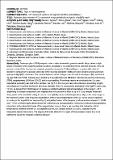Por favor, use este identificador para citar o enlazar a este item:
http://hdl.handle.net/10261/208805COMPARTIR / EXPORTAR:
 SHARE
BASE SHARE
BASE
|
|
| Visualizar otros formatos: MARC | Dublin Core | RDF | ORE | MODS | METS | DIDL | DATACITE | |

| Título: | Superspin glass behavior of Co nanocrystal arrays in MBE-grown Co/Ag multilayers |
Autor: | Navarro, Enrique CSIC ORCID ; Alonso, María CSIC ORCID; Ruiz, A.; Magén, César CSIC ORCID; Urdiroz, Unai; Cebollada, F.; Balcells, Lluis CSIC ORCID; Martínez Perea, Benjamín CSIC ORCID; Palomares, F. Javier CSIC ORCID; González Fernández, Jesús María CSIC ORCID | Fecha de publicación: | 2019 | Citación: | 10th International Symposium on Metallic Multilayers (2019) | Resumen: | Superspin glass (SSG) magnetic order has been often reported for granular metallic alloys, where a high degree of disorder in the magnetic particles positions constitutes a key ingredient of the collective behavior. Granular multilayers would in principle offer a reduced disorder in comparison to granular solids, due to the stacking periodicity. In fact, SSG behavior has been also reported for discontinuous metal-insulator multilayers, although we are not aware of similar SSG reports for metallic multilayers. In the present investigation we study the structure and magnetic properties of granular Co/Ag multilayers grown by molecular beam epitaxy (MBE) on MgO(001) substrates. The nominal thickness of the Co layers was 0.5 and 1 monolayers (ML) and that of Ag layers was 8 ML and 16 ML. X-ray reflectivity and diffraction measurements confirmed that a clear superlattice periodicity was built in the samples, see Fig.1. The cross-section transmission electron microscopy (TEM) images also illustrate a well-defined multilayer sequence and show that Co layers are discontinuous, presenting a highly monodisperse Co particle distribution. The magnetometry (VSM and SQUID) and acsusceptibility studies indicated that these multilayers exhibited hysteresis below temperatures in the range 5 - 20 K, magnetization not saturable at fields of up to 6 T, and sharp peaks in the zero-field cooling dc- and ac- susceptibility curves at low temperatures (Tp). The frequency dependence of Tp in the ac- curves can be explained according to the Vogel-Fulcher law and yielded values of the frequency shift parameter Γ in the range 0.04-0.05. Henkel plots indicated demagnetizing interactions at the whole field range of the magnetization process. Hence, we conclude that, below the critical temperatures identified from the ac- susceptibility curves, our samples behave as a SSG, originated by the interparticle dipolar interactions. The degree of disorder within the Co layers seems thus to be sufficient to cause this magnetic collective behavior. Finally, the dependence of some of the magnetic properties on Co concentration is discussed, including also results from Co/Ag multilayers with thicker Co layers (up to 4 ML). | Descripción: | Resumen del póster presentado al 10th International Symposium on Metallic Multilayers (MML), celebrado en Madrid (España) del 17 al 21 de junio de 2019. | URI: | http://hdl.handle.net/10261/208805 |
| Aparece en las colecciones: | (ICMA) Comunicaciones congresos (ICMAB) Comunicaciones congresos (ICMM) Comunicaciones congresos |
Ficheros en este ítem:
| Fichero | Descripción | Tamaño | Formato | |
|---|---|---|---|---|
| superspinmulti.pdf | 192,43 kB | Adobe PDF |  Visualizar/Abrir | |
| superspinmatrix.pdf | 331,61 kB | Adobe PDF |  Visualizar/Abrir |
CORE Recommender
Page view(s)
154
checked on 18-abr-2024
Download(s)
98
checked on 18-abr-2024
Google ScholarTM
Check
NOTA: Los ítems de Digital.CSIC están protegidos por copyright, con todos los derechos reservados, a menos que se indique lo contrario.
